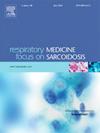Characterisation of patients with Alpha-1 antitrypsin deficiency using unsupervised machine learning tools
IF 3.1
3区 医学
Q2 CARDIAC & CARDIOVASCULAR SYSTEMS
引用次数: 0
Abstract
Background
Alpha-1 antitrypsin deficiency (AATD) is an underdiagnosed and clinically heterogeneous genetic disorder that increases the risk of pulmonary emphysema and liver disease. Its management is complex due to high individual variability, which hinders risk stratification and personalised treatment. Artificial Intelligence (AI), particularly Machine Learning (ML) techniques, may offer novel approaches to the clinical characterisation of AATD.
Materials and methods
A pilot, single-centre cross-sectional study was conducted, including 210 AATD patients from the EARCO registry at Álvaro Cunqueiro Hospital (Vigo, Spain), between February 2020 and June 2023. The unsupervised k-prototypes algorithm was applied to identify clusters based on clinical and demographic variables. Functional and clinical differences among clusters were analysed using Mann-Whitney U and Chi-square tests, with p < 0.05 considered significant. This pilot study, based on a regional cohort with high Pi∗SZ prevalence, explores the feasibility of applying AI in clinical practice without aiming to represent the full EARCO registry.
Results
Five clinically distinct clusters were identified: A) Pi∗ZZ patients with emphysema and severe functional impairment; B) women with bronchiectasis and preserved pulmonary function; C) young asymptomatic individuals with the Pi∗SZ genotype; D) older patients with COPD and cardiovascular comorbidities; E) individuals with altered hepatic profiles, alcohol consumption, and moderate AATD. Significant differences in pulmonary function, AAT levels, and comorbidities were observed.
Conclusions
This pilot study shows the feasibility of using ML to segment AATD patients into meaningful clusters, adding value for personalised medicine. This approach may guide therapeutic decisions, improve follow-up, and support the design of cluster-based multicentre trials.
使用无监督机器学习工具描述α -1抗胰蛋白酶缺乏症患者的特征
研究背景:α -1抗胰蛋白酶缺乏症(AATD)是一种未被诊断和临床异质性的遗传性疾病,可增加肺气肿和肝脏疾病的风险。它的管理是复杂的,由于高度的个体差异,这阻碍了风险分层和个性化治疗。人工智能(AI),特别是机器学习(ML)技术,可能为AATD的临床特征提供新的方法。材料和方法在2020年2月至2023年6月期间,对Álvaro Cunqueiro医院(Vigo, Spain) EARCO登记处的210名AATD患者进行了一项试点、单中心横断面研究。应用无监督k-原型算法识别基于临床和人口变量的聚类。聚类间功能和临床差异分析采用Mann-Whitney U检验和卡方检验,p <;0.05认为显著。这项基于高Pi * SZ患病率的区域队列的试点研究,探讨了在临床实践中应用人工智能的可行性,而不是旨在代表完整的EARCO注册。结果临床鉴定出5个不同的聚类:A) Pi * ZZ患者伴有肺气肿和严重功能障碍;B)支气管扩张且肺功能保留的女性;C) Pi * SZ基因型青年无症状个体;D)老年COPD合并心血管合并症患者;E)肝脏特征改变、饮酒和中度AATD的个体。观察到肺功能、AAT水平和合并症的显著差异。这项初步研究表明,使用ML将AATD患者划分为有意义的集群是可行的,为个性化医疗增加了价值。这种方法可以指导治疗决策,改善随访,并支持基于集群的多中心试验的设计。
本文章由计算机程序翻译,如有差异,请以英文原文为准。
求助全文
约1分钟内获得全文
求助全文
来源期刊

Respiratory medicine
医学-呼吸系统
CiteScore
7.50
自引率
0.00%
发文量
199
审稿时长
38 days
期刊介绍:
Respiratory Medicine is an internationally-renowned journal devoted to the rapid publication of clinically-relevant respiratory medicine research. It combines cutting-edge original research with state-of-the-art reviews dealing with all aspects of respiratory diseases and therapeutic interventions. Topics include adult and paediatric medicine, epidemiology, immunology and cell biology, physiology, occupational disorders, and the role of allergens and pollutants.
Respiratory Medicine is increasingly the journal of choice for publication of phased trial work, commenting on effectiveness, dosage and methods of action.
 求助内容:
求助内容: 应助结果提醒方式:
应助结果提醒方式:


